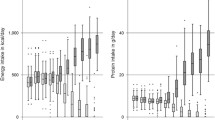Abstract
The fatty acid composition of 48 samples of banked human milk for preterm infants and four standard infants formulas available in Finland were analysed by capillary gas liquid chromatography. The banked milk was collected from mothers who had given birth 0–8 weeks previously. Saturated fatty acids accounted for approximately 50% of the fatty acids in both human milk and the formulas, while the relative content of monoenoic fatty acids tended to be higher in human milk than in the formulas. The relative content of 18∶2n−6 was higher in the formulas (range 14.7%–23.2%) than in human milk (median 9.1%, range 6.3%–13.4%). Fat of banked human milk contained 0.9% and 0.7% polyunsaturated fatty acids with 20 and 22 carbon atoms (LCP), respectively, which is comparable to that of fresh mature human milk. In contrast, LCP could not be detected in any of the formulas. Conclusion: Banked human milk is a good source of LCP and offers a good alternative to LCP containing formulas.
Similar content being viewed by others
Abbreviations
- LCP :
-
long-chain polyunsaturated fatty acids
References
Boersma ER, Offringa PJ, Muskiet FAJ, Chase WM, Simmons IJ (1991) Vitamin E, lipid fractions, and fatty acid composition of colostrum, transitional milk, and mature milk: an international comparative study. Am J Clin Nutr 53:1197–1204
Carlson SE, Rhodes PG, Ferguson MG (1986) Docosahexaenoic acid status of preterm infants at birth and following feeding with human milk or formula. Am J Clin Nutr 44:798–804
Clandinin MT, Chappel JE, Leong S, Heim T, Swyer PR, Change GW (1980) Intrauterine fatty acid accretion rates in human brain: implications for fatty acid requirements. Early Hum Dev 4:121–129
Clandinin MT, Chappel JE, Heim T, Swyer PR, Chance GW (1981) Fatty acid utilization in perinatal de novo synthesis of tissues. Early Hum Dev 5:355–366
Clandinin MT, Parrott A, Van Aerde JE, Hervada AR, Lien E (1992) Feeding preterm infants a formula containing C20 and C22 fatty acids simulates plasma phospholipid fatty acid composition of infants fed human milk. Early Hum Dev 31:41–51
Espgan Committee on Nutrition (1991) Comment on the content and composition of lipids in infant formulas. Acta Paediatr Scand 80:887–896
Farquharson J, Cockburn F, Patrick WA, Jamieson EC, Logan RW (1992) Infant cerebral cortex phospholipid fatty-acid composition and diet. Lancet 340:810–813
Folch J, Lees M, Sloane Stanley GH (1957) A simple method for the isolation and purification of total lipides from animal tissue. J Biol Chem 226:497–509
Koletzko B, Bremer HJ (1989) Fat content and fatty acid composition of infant formulas. Acta Paediatr Scand 78:513–521
Koletzko B, Mrotzek M, Bremer HJ (1988) Fatty acid composition of mature human milk in Germany. Am J Clin Nutr 47:954–959
Koletzko B, Schmidt E, Bremer HJ, Haug M, Harzer G (1989) Effects of dietary long-chain polyunsaturated fatty acids on the essential fatty acid status of premature infants. Eur J Pediatr 148:669–675
Luukkainen P, Salo MK, Nikkari T (1994) Changes in the fatty acid composition of preterm and term human milk from one week to six months of lactation. J Pediatr Gastroenterol Nutr 18:355–360
Neuringer M, Connor WE, Lin DS, Barstad L, Luck S (1986) Biochemical and functional effects of prenatal and postnatal ω3 fatty acid deficiency on retina and brain in rhesus monkeys. Proc Natl Acad Sci USA 83:4021–4025
Ponder DL, Innis SM, Benson JD, Siegman JS (1992) Docosahexaenoic acid status of term infants fed breast milk or infant formula containing soy oil or corn oil. Pediatr Res 32:683–688
Ruyle M, Connor WE, Anderson GJ, Lowensohn RI (1990) Placental transfer of essential fatty acids in humans: venous-arterial difference for docosahexaenoic acid in fetal umbilical erythrocytes. Proc Natl Acad Sci USA 87:7902–7906
Uauy RD, Birch DG, Birch EE, Tyson JE, Hoffman DR (1990) Effect of dietary omega-3 fatty acids on retinal function of very-low-birth-weight neonates. Pediatr Res 28:485–492
Vuori E, Kiuru K, Mäkinen SM, Väyrynen P, Kara R, Kuitunen P (1982) Maternal diet and fatty acid pattern of breast milk. Acta Paediatr Scand 71:959–963
Zoeren-Grobben D van, Moison RMW, Ester WM, Berger HM (1993) Lipid peroxidation in human milk and infant formula: effect of storage, tube feeding and exposure to phototherapy. Acta Paediatr 82:645–649
Author information
Authors and Affiliations
Rights and permissions
About this article
Cite this article
Luukkainen, P., Salo, M.K. & Nikkari, T. The fatty acid composition of banked human milk and infant formulas: The choices of milk for feeding preterm infants. Eur J Pediatr 154, 316–319 (1995). https://doi.org/10.1007/BF01957370
Received:
Accepted:
Issue Date:
DOI: https://doi.org/10.1007/BF01957370




